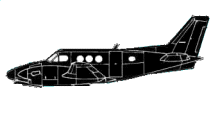
ASN Wikibase Occurrence # 28242
This information is added by users of ASN. Neither ASN nor the Flight Safety Foundation are responsible for the completeness or correctness of this information.
If you feel this information is incomplete or incorrect, you can submit corrected information.
| Date: | Tuesday 1 May 1979 |
| Time: | |
| Type: |  Beechcraft 90 King Air |
| Owner/operator: | Government of Canada/Department of Transportation |
| Registration: | C-FCAS |
| MSN: | LJ-23 |
| Fatalities: | Fatalities: 2 / Occupants: 2 |
| Aircraft damage: | Destroyed |
| Location: | near Sherrington, QC -
 Canada Canada
|
| Phase: | En route |
| Nature: | Calibration/Inspection |
| Departure airport: | |
| Confidence Rating: |
Aircraft was utilized for the calibration of navigation and approach aids by the Airways Branch of the Department of Transport regional office at Dorval, Quebec.
Part of starboard wing fell off & aircraft crashed from 1700 ft 5 km NW of Sherrington, QC into open farm land.
Investigation was performed by the Aviation Safety Bureau (ASB) of the Canadian Air Transportation Administration (CATA), a branch of the Department of Transport (also known as Transport Canada).
Mandatory inspections of Beechcraft 90s were specified by an Airworthiness Directive (AD) issued by the FAA, requiring inspections of the lower forward outboard wing attachment fittings, with the first inspection before 5000 hours, and subsequent inspections at 500 hour intervals. These called for a dye penetrant test to check for cracks.
The initial inspection was done at 4907 hours, but the documentation was ambiguous, did not state that the dye test was done, and the physical examination of the relevant parts were inconclusive into whether a dye test was done at 4907 hours. However, the ASB took the word of the mechanic that did the inspection that the dye test was done, and that it did not reveal any cracking. They also concluded that even if the dye test was not done, they believe that no cracking had developed at that point in time.
However, the plane was not inspected at 5407 hours, as the investigators claimed that the AD was ambiguous, and the Department of Transport was convinced that an inspection was only required if wing panel skin cracks were found. The investigators also found that other operators of the Beechcraft 90 interpreted the AD in different ways, supporting their argument.
The Aviation Safety Engineering division of the ASB also found that the AD was not adequate in its inspection intervals, as they found two cracks in the fittings of other Beechcraft long before the 5000 hour mark, found a generic defect in the fitting, and recommended a stronger and more concise AD to address these issues.
As the investigation into the structural breakup of a Department of Transport plane was conducted by a branch of the Department of Transport, the FAA and Beechcraft believed that there was a serious conflict-of-interest and viewed the findings with suspicion, particularly the findings about the generic defect in the fitting and the recommendation for a stronger AD.
Sources:
AL 005
AL 152
Report of the Commission of Inquiry on Aviation Safety (Dubin Report, pg. 123-127): https://publications.gc.ca/collections/collection_2017/bcp-pco/T52-58-1-1981-eng.pdf
Revision history:
| Date/time | Contributor | Updates |
|---|---|---|
| 27-Sep-2008 01:00 | ASN archive | Added |
| 27-Feb-2013 06:09 | wf | Updated [Aircraft type, Cn, Location, Country, Phase, Source, Damage, Narrative] |
| 04-Mar-2013 01:24 | wf | Updated [Operator, Source] |
| 18-Nov-2022 06:32 | Ron Averes | Updated [Aircraft type] |
| 26-Dec-2023 08:14 | Lwo98 | Updated [Nature, Source, Narrative] |
Corrections or additions? ... Edit this accident description
The Aviation Safety Network is an exclusive service provided by:


 ©2024 Flight Safety Foundation
©2024 Flight Safety Foundation